5.1 vs 7.1 vs 9.1 Speaker Layouts: Which Setup Is Best for Your Home Theater?
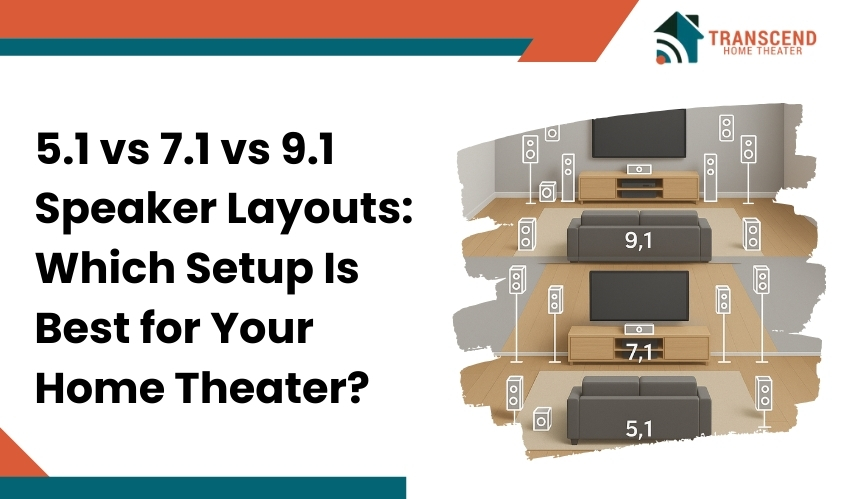
A home theater is only as good as its speaker layout. The way you position and configure speakers directly shapes the depth of sound, dialogue clarity, and overall immersion during movies, gaming, or music playback.
Speaker layouts represent different levels of surround sound experience, ranging from the classic 5.1 setup with six audio channels to the more advanced 7.1 and 9.1 systems that expand sound coverage and realism.
This guide breaks down 5.1 vs 7.1 vs 9.1 speaker layouts, explaining the strengths and drawbacks of each. You will get clear direction on which setup best matches your home theater goals.
What Do Home Theater Speaker Layout Numbers Mean?
When you see a label like 5.1, 7.1, or 9.1, it is not random. These numbers describe how many speakers and subwoofers make up a surround sound system.
- The first number represents the total speaker channels. For example, in a 5.1 system, the “5” means there are five speakers: left, right, center, and two surround speakers.
- The “.1” represents the subwoofer. The subwoofer is responsible for low-frequency sounds like explosions, bass lines, or rumbling effects. Every layout from 5.1 upward includes at least one subwoofer.
So, a 7.1 setup means seven speakers plus one subwoofer, while a 9.1 setup means nine speakers plus one subwoofer. As the number of speakers increases, the system delivers more detailed sound placement, a broader soundstage, and higher immersion.
In short, the numbering system is a simple way to understand how many audio channels and bass channels are present in a given home theater configuration. This knowledge makes it easier to compare setups and decide whether you need a basic surround system or a more advanced layout for a cinematic experience.
5.1 Speaker Layout: The Classic Surround Setup
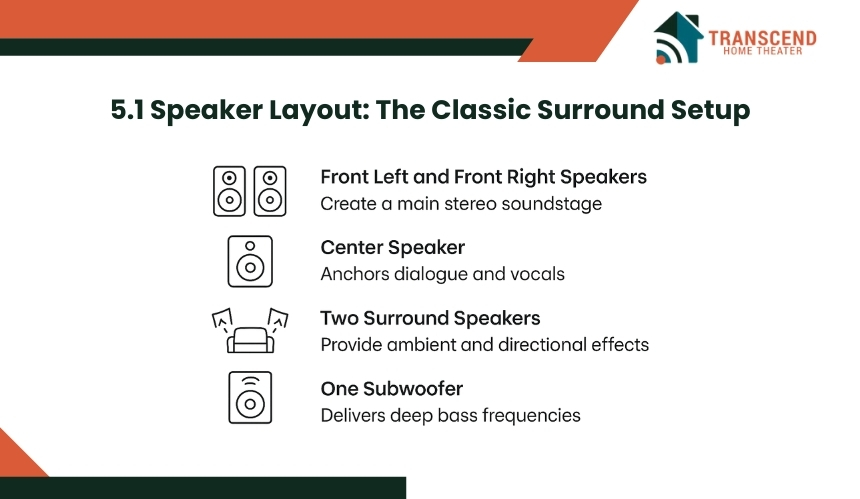
A 5.1 speaker system is the most common and widely adopted surround sound configuration. It remains the foundation for anyone beginning their home audio setup, as it balances affordability, simplicity, and cinematic immersion.
Components of a 5.1 Speaker Setup
- Front Left and Front Right Speakers: These speakers create the main stereo soundstage, handling music, background effects, and directional audio cues. They provide depth and width to the audio, making the sound feel like it extends beyond the screen.
- Center Speaker: This is the anchor for dialogue and vocals. It ensures that conversations, narrations, and on-screen voices stay clear and locked to the center of the screen, even when effects are happening around you.
- Two Surround Speakers: Positioned to the sides or slightly behind the seating area, these speakers generate ambient effects, such as footsteps, background chatter, or environmental sounds. They make you feel like the action is happening all around you instead of just in front.
- One Subwoofer: The subwoofer is responsible for deep bass and low-frequency effects. Explosions, rumbles, and musical bass lines gain impact and realism through the subwoofer, adding power and excitement to movies, games, and music.
Advantages of a 5.1 Speaker Layout
A 5.1 surround sound system delivers an impressive balance of performance, practicality, and accessibility. Its advantages include:
- Affordability without compromise: 5.1 systems offer cinematic sound at a fraction of the cost of larger configurations. This makes them a budget-friendly entry point into home theater audio.
- Simple setup and maintenance: With only six total audio channels, installation is straightforward. The wiring is manageable, and calibration requires less effort compared to more advanced systems.
- Compatibility with most devices and media: Nearly every AV receiver, Blu-ray disc, streaming service, and gaming console supports 5.1 surround sound. This ensures seamless integration with your existing equipment.
- Optimized for compact spaces: The layout fills small to medium-sized rooms with immersive audio, creating a spacious surround effect without overwhelming the environment.
Limitations of 5.1 Speaker Layout
While a 5.1 setup is powerful, it cannot match the directional depth or rear-channel realism of larger systems. In big rooms, sound may feel less enveloping because only two speakers handle the surround effects.
Who Should Choose a 5.1 Speaker System?
A 5.1 home theater system is best for viewers who value simplicity and dependable performance without unnecessary complexity. It is the smart choice if:
- You are setting up your first home theater: A 5.1 layout offers an accessible introduction to surround sound. This allows you to enjoy immersive audio without needing advanced technical knowledge.
- You watch from a central seating position: The layout works perfectly when your seats are close to the screen, ensuring sound reaches you evenly from all directions.
- You prefer a clean and minimal design: With fewer speakers to position, the system blends easily into living rooms and multipurpose spaces while still delivering impactful audio.
- You want reliable performance across everyday entertainment: Whether it’s streaming movies, casual gaming, or family TV nights, a 5.1 system covers all the essentials without feeling excessive.
7.1 Speaker Layout: The Enhanced Surround Experience
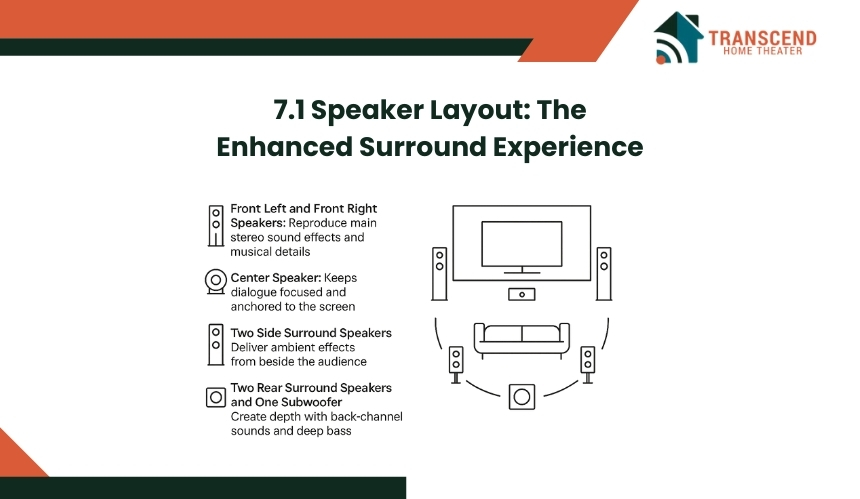
A 7.1 surround sound system builds upon the 5.1 foundation by adding two additional speakers at the rear. In larger rooms, achieving the full effect often depends on professional home theater design and installation. Precise speaker placement and calibration bring out the system’s true potential.
Components of a 7.1 Speaker Setup
- Front Left and Front Right Speakers: Reproduce main stereo sound effects and musical details.
- Center Speaker: Ensures dialogue remains sharp and centered on-screen, even during action-heavy scenes.
- Two Side Surround Speakers: Positioned to the left and right of the seating area, they handle ambient effects like crowd noise, wind, or transitional sounds.
- Two Rear Surround Speakers: Placed behind the seating area, these speakers add depth by producing back-channel audio such as footsteps approaching from behind or vehicles moving past.
- One Subwoofer: Provides low-frequency effects, intensifying bass-driven moments like explosions or cinematic music scores.
Advantages of a 7.1 Speaker Layout
- Expanded soundfield: With rear channels added to the standard 5.1 design, a 7.1 setup produces audio that wraps fully around the listener. This enhances spatial realism.
- True-to-source playback: Many Blu-ray discs, streaming titles, and modern games are mixed in 7.1, and this layout allows you to hear them as the creators intended.
- Cleaner layering of effects: Side and rear channels handle different audio elements, preventing clutter and giving every effect its own space in the soundstage.
- Ideal balance for larger environments: The configuration fills wide or deep rooms evenly, reducing the chance of weak spots in the surround experience.
Limitations of a 7.1 Speaker Layout
A 7.1 system requires a bigger investment, additional wiring, and more careful calibration. It also needs adequate space to position the rear speakers properly. In small rooms, the added channels can feel unnecessary and may not provide a noticeable improvement over 5.1.
Who Should Choose a 7.1 Speaker System?
A 7.1 setup is best suited for home theater owners who want to go beyond the basics and fully immerse themselves in content. It is especially valuable for:
- Dedicated theater rooms: Where the space allows for accurate placement of side and rear channels.
- Movie enthusiasts and serious gamers: Who want maximum immersion and appreciate the finer details in film scores, background effects, and directional audio.
- Those upgrading from 5.1: If you already enjoy surround sound but crave a fuller and more continuous sound environment, 7.1 is the logical next step.
- Listeners seeking precision: Perfect for users who notice subtle differences in sound design and want every effect to feel intentional and well-positioned.
9.1 Speaker Layout: The Premium Immersive Setup
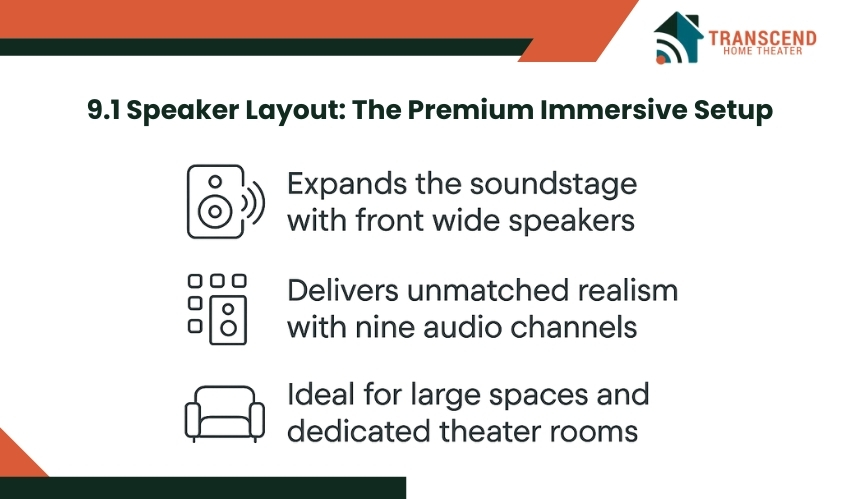
A 9.1 home theater system takes immersion to the highest level within traditional surround sound formats. It builds upon a 7.1 layout by adding front wide speakers, which bridge the gap between the front and side channels.
Components of a 9.1 Speaker Setup
- Front Left and Front Right Speakers: Reproduce the main stereo elements, including music, directional effects, and environmental details.
- Center Speaker: Handles all dialogue and central audio cues, ensuring voices stay sharp and anchored to the screen regardless of where you sit.
- Two Side Surround Speakers: Positioned directly beside the audience to deliver ambient effects such as rain, crowd noise, or environmental movement.
- Two Rear Surround Speakers: Placed behind the seating area to add depth, allowing sound to travel naturally from front to back and creating convincing motion effects.
- Two Front Wide Speakers: Installed between the main front speakers and the side surrounds, these expand the soundstage horizontally.
- One Subwoofer: Produces low-frequency sounds such as deep bass, rumbles, and explosions, adding weight and impact to action scenes and music.
Advantages of a 9.1 Speaker Layout
- Unmatched spatial coverage: The front wide speakers eliminate gaps in the sound field, creating continuous audio movement across the front and side walls. This makes sweeping effects, such as cars racing past or aircraft flying overhead, feel fluid and uninterrupted.
- Exceptional cinematic immersion: With nine speakers working together, the system recreates the layered sound environment of a professional theater. This allows you to experience films and games with greater realism and depth.
- Highly precise sound placement: Each effect is assigned to a distinct channel, allowing you to clearly identify where sounds originate. From subtle background details to sudden directional cues, everything is delivered without any audio overlap.
- Superior performance in large rooms: A 9.1 setup ensures even distribution of sound across wide spaces or multiple rows of seating. This prevents dead zones and giving every listener the same immersive experience.
Limitations of a 9.1 Speaker Layout
A 9.1 system delivers premium results, but it comes with significant trade-offs. The cost of purchasing additional speakers and a capable AV receiver is considerably higher than smaller systems.
Installation of the 9.1 system is more complex, with extra wiring and calibration required to achieve balanced sound. Most importantly, it demands a large room; in smaller spaces, the benefits of extra channels can feel minimal compared to the effort and expense.
Who Should Choose a 9.1 Speaker System?
A 9.1 configuration is designed for enthusiasts who are serious about achieving the highest level of surround sound performance. It is best suited for:
- Home theater purists: If your goal is to recreate the audio experience of a commercial cinema, a 9.1 setup provides the scale, precision, and dynamic range needed for professional-grade sound.
- Owners of large dedicated rooms: This system shines in wide or deep spaces with multiple seating rows, where additional speakers ensure consistent immersion for every viewer.
- Detail-oriented listeners: Perfect for those who pay attention to subtle sound cues and want audio transitions, such as a conversation moving across a room or the gradual sweep of a soundtrack, to feel completely natural.
- Experienced upgraders: Ideal for users who have already lived with a 7.1 system and are ready to expand. With proper acoustic treatment and calibration, upgrading to 9.1 can unlock a new level of realism.
5.1 vs 7.1 vs 9.1: At a Glance

The table below highlights the main differences between 5.1, 7.1, and 9.1 speaker layouts. Each column shows how many speakers are included, what extra channels are added, and how they differ in terms of setup, budget, and room suitability.
Feature | 5.1 Speaker System | 7.1 Speaker System | 9.1 Speaker System |
Number of Channels | 5 speakers + 1 subwoofer | 7 speakers + 1 subwoofer | 9 speakers + 1 subwoofer |
Added Speakers | Standard surround layout | Rear surrounds for back-channel effects | Front wide speakers for expanded soundstage |
Sound Coverage | Strong immersion in small to mid-sized rooms | Complete 360-degree surround effect | Seamless audio transitions across all directions |
Room Size Suitability | Best for small to medium living rooms | Medium to large rooms with proper depth | Large, dedicated home theater spaces |
Installation Complexity | Easy to set up with minimal wiring | Requires careful placement of rear speakers | Demands significant space, wiring, and calibration |
Budget Level | Entry-level, most affordable | Mid-range investment | High-end, premium cost |
Content Compatibility | Universally supported by movies, games, and streaming services | Supported by Blu-rays, games, and streaming mastered in 7.1 | Limited native content often relies on upmixing for full use |
Immersion Level | Solid surround experience | More accurate directional effects | Closest to professional cinema sound |
In short, 5.1 is the best entry point, 7.1 offers a richer surround field for larger rooms, and 9.1 delivers the most cinematic experience but requires space, calibration, and budget.
Common Mistakes in Home Theater Speaker Placement
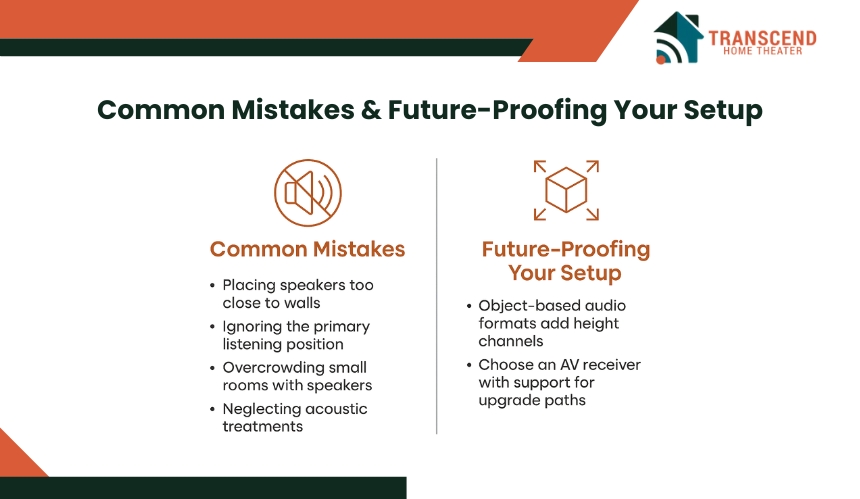
Even with the right speaker layout, poor placement can ruin the experience. Some of the most frequent mistakes include:
- Placing speakers too close to walls: When speakers are pressed against walls or corners, sound reflections distort clarity and reduce the sense of direction. Proper spacing allows audio to breathe naturally.
- Ignoring the listening position: The seating area is the reference point for placement. If speakers are angled incorrectly or positioned unevenly, the sound field feels unbalanced.
- Overcrowding small rooms with too many speakers: Adding extra channels in a limited space can create clutter and muddy the sound. Choosing the right layout for the room is more effective than forcing additional speakers.
- Neglecting acoustic treatment: Hard surfaces such as bare walls and floors cause echoes and harsh reflections. Simple treatments like rugs, curtains, or wall panels improve overall sound quality.
- Incorrect subwoofer placement: A subwoofer placed randomly can create uneven bass. Positioning it along a wall or using a corner strategically can smooth out low-frequency performance.
Future-Proofing Your Home Theater Setup
Technology in home entertainment continues to evolve. While 5.1, 7.1, and 9.1 remain the core layouts today, many new formats focus on object-based audio such as Dolby Atmos and DTS: X. These systems add height channels, making sound feel three-dimensional.
Another way to stay future-ready is by investing in a strong AV receiver with support for modern audio formats, room calibration software, and upgrade paths. A well-planned setup allows incremental upgrades. For example, starting with 5.1 and later expanding to 7.1 or beyond.
For those looking to build or upgrade a theater room, professional design ensures that the system not only fits current needs but can adapt to new standards as they emerge. Transcend Home Theater offers expert planning, installation, and calibration to create setups that are immersive today and ready for tomorrow.
Every home theater is different, and the best way to hide wires depends heavily on the type of installation. Wall-mounted TVs, ceiling projectors, and surround sound speakers each bring unique wiring challenges that benefit from tailored solutions.
Frequently Asked Questions (FAQs)
Is Dolby Atmos better than 7.1 or 9.1 surround sound?
Dolby Atmos is not a traditional channel-based system like 5.1, 7.1, or 9.1. Instead, it is an object-based audio format that adds height channels for overhead effects. While 7.1 and 9.1 create a horizontal sound field, Atmos extends the experience vertically, offering more realism in supported movies and games.
Can I use wireless speakers in a surround sound setup?
Yes, many modern AV receivers support wireless or Wi-Fi-enabled surround speakers. While wired connections are still preferred for stability, wireless options reduce cable clutter and make placement more flexible, especially in multipurpose living rooms.
Do streaming platforms support 7.1 and 9.1 audio?
Most major platforms, such as Netflix, Disney+, and Apple TV+ provide 5.1 audio as standard. Some content is available in 7.1 on services like Netflix and Apple TV+, although the catalog is limited compared to Blu-ray releases. Native 9.1 streaming is not available, and receivers usually create it through upmixing. For consistent access to 7.1 tracks, Blu-ray and UHD Blu-ray discs remain the most reliable source.
Can I upgrade from 5.1 to 7.1 or 9.1 without replacing everything?
Yes, if your AV receiver supports additional channels, you can expand by adding speakers gradually. Many users start with 5.1 and upgrade to 7.1 or 9.1 later as room size, budget, and interest allow.
What is the ideal seating position for surround sound?
The best seating position is centered between the front left and right speakers, with the listener’s ears at roughly the same height as the tweeters. Surround speakers should be slightly above ear level, and subwoofer placement should be tested to find the spot with the smoothest bass response.
